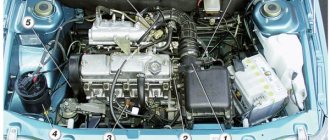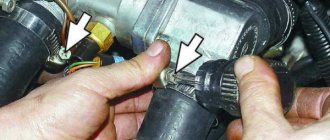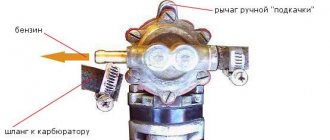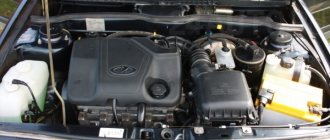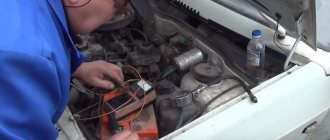Driver signals
A specially equipped sensor in each vehicle will currently help to systematically monitor or monitor the temperature of the liquid in the cooling system. In more modern cars it can be slightly modified and display indicators using LEDs, but the essence does not change, the purpose remains the same - to help the driver in signaling the readings.
If you blinked and sent the sensor needle into the red zone, then expect a column of steam from under the hood of your friend in a few seconds. Believe me, there is nothing good here, and no one knows how it will all end.
The concept and principle of operation of a thermostat
Now the physical side of the “coin”. Even from driving school, we know that an automobile cooling system consists of large and small circles through which some liquid or water circulates. When starting the engine and up to 90°C
the liquid flows in a small circle, from 90°C and above the thermostat opens and allows flow in a large circle to reduce the overall temperature by lengthening the flow chain.
Accordingly, breakdowns in the thermostat can lead to its failure to open in a timely manner and the coolant to boiling. This means expect a “hello” from the piston rings.
You can check the functionality of the thermostat as follows:
start and heat the engine to 90°C and feel the radiator pipe; if it is hot, then the thermostat is working, otherwise look for an urgent replacement. If it happens that the thermostat is unusable, then we buy its working analogue in any auto shop or on the market and get ready to replace it yourself.
Causes of engine overheating
The temperature indicator needle has entered the red zone, which means the engine is overheating
car enthusiasts Many remember the reasons for the effect on “old” Zhiguli cars. On 16-valve engines, the reasons for this effect are almost the same. Let's look at what reasons could cause the main power unit to start to overheat:
- The system is clogged.
- thermostat stuck.
- Damage to the pump. Replace the pump. About pump selection for a 16 valve engine here.
- Radiator.
- sensor Cooling fault.
- The cooling fan does not operate (see “fan relay).”
Troubleshooting
The logical solution to the problem, in this case, is to replace either the thermostat itself or the component thermoelement. Both options are quite cheap, since we are talking about a domestic manufacturer, there is no need to buy any analogues. This procedure can easily be carried out independently, but if you do not know the technical component of the VAZ-2110, it is still better to contact specialists at service stations. The most important thing is to first drain all the antifreeze in the system.
As a result of the replacement, the car’s instrument scale should show an engine temperature of at least 90 degrees after 20-30 minutes of warming up or 10-15 minutes of driving without prior waiting. The thermostat scale must be monitored periodically, at least once every 15 minutes of travel. A quick glance is enough to ensure that the engine temperature is within the required range, which will automatically indicate the integrity and suitability of the thermostat itself.
Long warm-up can also be a consequence of incorrectly selected antifreeze for the cooling system, but such cases, as practice shows, are rare.
Engine overheating
Coolant overheat alarm
Most cars are equipped with a temperature sensor that measures the operating temperature of the engine. If the overheat warning light comes on while driving (or the temperature gauge goes into the red hot zone), the coolant temperature is between 120°C and 126°C. This temperature still remains below the boiling point of the coolant (provided that the cooling system and the radiator seal are in good condition). If the coolant overheat warning light comes on, do the following:
Step 1. Turn off the interior air conditioning and turn on the interior heater. This will help remove excess heat from the engine faster. Set the fan to maximum rotation speed.
Step 2: If possible, turn off the engine and allow it to cool (this may take more than an hour).
Step 3. Do not under any circumstances attempt to remove the radiator seal until the engine has cooled down.
Step 4: If the overheat warning light is on, do not continue driving, otherwise the engine may be seriously damaged.
Step 5. If the engine does not glow with heat and is not clearly overheated, then the problem may be due to a malfunction of the temperature sensor or temperature indicator. Then you can continue driving, but to be on the safe side, you need to stop from time to time to check for signs of engine overheating and for signs of coolant leakage.
COMMON CAUSES OF ENGINE OVERHEATING
• Low coolant level.
• Clogged, dirty or blocked radiator.
• Faulty fan clutch or faulty electric fan.
• Incorrectly set ignition timing.
• Low oil level in the engine lubrication system.
• Broken fan drive belt.
• Faulty radiator seal.
• Coolant freezing (in frosty weather).
• Faulty water pump of the cooling system (slippage of the impeller on the inner shaft of the pump).
The owner complained that his car's engine overheated, but this only happened when he was driving on the freeway at high speeds. The car was equipped with an engine that worked flawlessly when driving in the city cycle.
The mechanic flushed the cooling system and replaced the radiator seal and water pump, believing that the cause of the overheating was a decrease in coolant flow in the cooling system. During further inspection, it was revealed that when the engine is cranked by the starter with the spark plugs unscrewed, coolant sprays out of one of the cylinders. The problem was resolved after the cylinder head gasket was replaced. Obviously, the leak caused by a defective gasket was not large enough to cause engine malfunction - as long as the speed and load on the engine did not increase so much that the resulting increase in coolant leakage and heat generation did not lead to a rapid increase in temperature.
The mechanic also replaced the oxygen (02) sensor, because the coolant contains organosilicon compounds and silicates, which, if they get on this sensor, usually poison it. Sensor degradation may have contributed to this problem.
Rice. 7.42. In the mid-1980s, many manufacturers began using serpentine belt drives (a belt with longitudinal V-shaped ribs instead of transverse teeth). Older water pumps will fit the engine, but they may turn in the opposite direction than they should. This may cause the engine to overheat after replacing the pump. If you install the wrong type of fan, then the angle of attack of its blades will not correspond to that required to create the necessary air flow through the radiator
For the correct operation of the cooling system, the condition and correct installation of the drive belt is of great importance. The tension of the drive belt has a decisive influence not only on the operating mode of the water pump, but also on the alternator, air conditioning compressor and other belt-driven units. When replacing a belt or adjusting its tension, be sure to measure the belt tension using a belt tension meter to ensure that it is exactly as required.
The engine gets very hot
It is worth noting that a carburetor engine encounters this problem much less often than an injection engine. Even on hot summer days it holds the temperature well and does not exceed 96 degrees. Why does the engine get hot?
- The thermostat malfunctions. As they say, the valve “caught the wedge.” This can be checked very simply: you need to touch the bottom of the thermostat with your hand. If it is cold, then the problem is in the thermostat valve. Another sign of a non-working thermostat: the radiator outlet is very overheated. As a result, this valve is kept closed, the liquid does not enter the radiator and boils. If in this state it penetrates into the piston part, as well as into the oil sump, this can lead to critical engine failure. Therefore, if a malfunction is detected, you need to turn off the engine and replace the thermostat with a working one.
The appearance of an air lock in the radiator pipes. To eliminate this problem you will have to bleed the entire system. The radiator is clogged. To avoid this problem, you need to clean the radiator regularly, especially during the hot summer season.
You also need to use only high-quality coolant to avoid clogging the radiator from the inside. You can also pay attention to whether the fan is broken. Another common reason that the VAZ 2106 engine may overheat is a breakdown of the water pump. The pump often leaks
You can check the operation of this part as follows: at engine operating temperature, sharply squeeze the inlet pipe on the radiator. In this case, the working pump produces a noticeable pulsation. It also doesn’t hurt to check the pump seal, which starts to leak from time to time.
The engine does not reach operating temperature
You can monitor the temperature readings of the power unit directly from inside the car. The dashboard of all modern cars has a small information field, usually round or semicircular in shape, showing the driver the coolant temperature readings. This is the device that gives an idea of the temperature conditions in which the engine is operating at a given time.
If the temperature gauge does not reach 90 degrees during a long trip, you should seriously think about finding the cause of the deviation from the normal operation of the power unit. It is not recommended to delay its diagnosis, because prolonged operation of the motor in this mode will lead to wear of its internal components.
The fact is that the electronic control unit, which is popularly called the “brains” of the car, recognizes an engine that has not reached the nominal temperature as cold, and therefore the fuel system injects an over-enriched mixture.
Is it necessary to warm up the engine at all, when and why is this done?
Motorists have known about the need to warm up before driving almost since childhood. Moreover, after driving a cold car, many are immediately convinced that driving with a cold engine is less comfortable.
For example, on carburetor cars the engine reacts jerkily to the fuel supply or even stalls, the injection unit is noisy and pulls worse. And, according to experts, it consumes much more fuel. And only after some time and warming up, the operation of the power unit returns to normal.
One of the reasons for such operation of the internal combustion engine lies in the fact that the structural parts do not completely fit together, but have some gaps, due to which during operation of a “cold” engine the sound is louder, and even light knocking can be heard. When heated, metals expand. The gaps are correspondingly reduced. The result is quieter operation.
The second reason is the consistency of the engine oil. Cold oil is less fluid, which means it will lubricate rubbing parts worse and slower. For example, the camshaft bearings are located relatively far from the oil pump and it takes a long time for lubricant to reach them. This is especially noticeable at low temperatures and viscous oil.
If these parts do not have enough lubrication, then within a few seconds after the engine is running under good load they will begin to wear out heavily. Along the way, the shaft itself with the cylinder head will be damaged. In addition, gearboxes also need good lubrication. With cold transmission oil, for the reasons stated above, the service life of the gearbox will be significantly reduced under load.
The third reason for poor performance of a cold engine is related to the outside air. When cold air is sucked into the engine, it creates a lean air-fuel mixture due to more oxygen in it. This leads to a drop in power and fuel consumption. After all, in order for the carburetor engine not to stall, the driver has to turn on the choke, that is, increase the supply of the fuel mixture. Although in modern injection cars the mixture is enriched automatically, the principle remains similar.
We also recommend reading the article about why engine temperature drops while driving. From this article you will learn about the sleepy reasons why the engine cools down while driving.
So, as can be seen from all of the above, preheating a modern internal combustion engine, if not extremely necessary, is then very desirable. However, a problem often arises: the engine takes a long time to heat up. It is especially acute in cold weather. There may be several reasons for this phenomenon. Let's figure it out.
Thermostat and fan malfunctions
A symptom of a faulty thermostat is a sudden increase in temperature for no apparent reason. That is, the car engine was operating in normal mode, there was no long standing in traffic jams or driving in first gear, and the instrument needle was close to the critical mark. Why is this happening? The fact is that, as a rule, the thermostat gets stuck in the closed position.
In this case, the liquid continues to circulate bypassing the radiator, which is not enough to cool the engine. Determining whether the thermostat is really at fault is very simple. It is necessary to warm up the engine to a temperature of 90 °C. Now you should evaluate the temperature of the pipe that goes to the radiator. If it is cold, the thermostat must be replaced.
Unlike the previous case, engine overheating is preceded by prolonged operation in low gears. In this mode, the VAZ 2110 radiator does not have sufficient airflow and when the temperature reaches 95 ° C, a sensor is triggered that turns on the fan. If this does not happen, engine overheating is inevitable. Such damage is complicated by the fact that faults, in addition to the fan itself, can occur in its power supply circuit.
As a special case, a blown fuse should be mentioned.
If the fan motor starts to spin when the contacts are closed, the sensor is faulty. If not, then the problem may be in the fuse and you need to check it. If it is in good working order, further repairs require skills and the presence of a special device, so it is better to contact a specialist.
Let's look at the most likely causes of engine overheating
1. The reasons may be different. The most common is a lack of coolant. The reason for overheating of the VAZ 2106 engine may be too little antifreeze in the car’s cooling system. Coolant can be lost due to unnoticeable cracks and small holes in various places.
For those who understand something about the structure of a car, it will not be difficult to detect this problem. If you do not use the vehicle for some time, you may notice spilled antifreeze on the asphalt. You will need to check the car's radiator or hose. The only solution is to replace the damaged parts.
If no coolant leakage is detected, then the cause may be in the engine. If antifreeze flows into the inside of the engine, then a very complex repair is needed and cannot be done without professionals. This may cause water hammer. Therefore, you need to immediately contact the service station.
2. The reason may be in the VAZ 2106 radiator fan. Check the belt tension level. If the fan has a temperature sensor, then it may be faulty. It is necessary to monitor the condition of the radiator, as this also affects engine overheating. If, after careful care, the engine continues to boil, you should buy a new radiator.
3. A broken thermostat may be one of the reasons for engine overheating. Its internal parts may lose their characteristics over time. And driving on congested streets, standing in traffic jams and at traffic lights - lead to the engine getting very hot due to poor airflow. Only at high speeds does the cooling system work perfectly.
4. On older VAZ 2106 cars, the ignition may be set incorrectly, which leads to overheating. But this is rare, because all modern cars are equipped with electronics and everything is controlled by a computer.
5. The last cause of overheating may be a burst engine exhaust valve. Hot gases enter the motor, and it heats up to a high temperature, as indicated by the arrow on the sensor.
Source
How to understand that the engine is overheating: signs
Overheating the engine, even once, is fraught with unpleasant consequences. To avoid such a malfunction, it is necessary to monitor the temperature of the internal combustion engine and its condition.
The main symptoms of engine overheating:
- moving the coolant temperature arrow on the dashboard to the red zone (from 120 degrees);
- on many cars, in addition to the temperature scale, there is an indicator on the panel that lights up when the temperature range is exceeded, and this may also be accompanied by a specific sound;
- significant reduction in traction and power of the vehicle;
- louder operation of the internal combustion engine, in which you can notice ringing metallic sounds;
- when the engine overheats significantly, a white coating appears on the spark plugs and visible damage to them;
- in case of severe overheating, an external inspection of the condition of the engine can reveal leaks of antifreeze, oil, cracks in the housing and deformation of individual parts of the internal combustion engine;
- the appearance of dark flakes in the coolant and darkening on the walls of the expansion tank (this check must be carried out after a significant decrease in engine temperature);
- foaming of the engine oil or changing its color to gray-reddish;
- the radiator fan is constantly on or does not turn on when driving in warm weather in traffic jams or at low speed;
- the appearance of steam under the hood, indicating that the coolant is boiling.
Consequences of untimely elimination of defects
Not all drivers realize what consequences can be caused by an engine overheating, and continue to drive with a constantly running fan or frequent overheating. So, the consequences of strong engine heating are divided into 3 stages, which are worth considering separately.
Slight overheating
If the engine overheats for up to 10 minutes, the consequences may be minor. Thus, cracks will appear in the pipes of the cooling system, the temperature sensor will fail, the oil scraper rings will become deformed, and the valve and camshaft seals will melt. Also, the valves will burn out, and oil will enter the combustion chambers, which will be marked by the release of black smoke from the exhaust system.
Consequences of slight overheating, namely burnout of valves.
Significant overheating
With significant overheating, deformation occurs, or rather deflection of the cylinder head. To eliminate these consequences, you will have to dismantle the cylinder head and submit it for surface grinding. Thus, it turns out that the block head is subject to major repairs.
Burnout of the piston group due to significant overheating Measuring the deflection of the cylinder head using a ruler
Severe overheating
With severe overheating, the walls of the cylinder block become deformed and burn out, causing melting of the piston group, deformation of the connecting rods, or even breakage of the crankshaft. Thus, the engine cannot be repaired, since usually the walls of the power unit collapse and their restoration is impossible.
Burnout and deformation of pistons after severe overheating Melting of the walls of the cylinder block after overheating
Refinement of the cooling system
Domestic cars are far from perfect, that's a fact. Lada Priora was no exception in this regard, having inherited many shortcomings from the legendary “ten”. One of them is an unfinished cooling system.
There are several ways to quickly and without financial costs modify the SOD on Priora.
- Installing a 6-hole thermostat (stable maintenance of coolant temperature).
- The use of Kalina SOD on Priora will reduce the pressure in the system and provide quick warm-up at subzero temperatures.
- Installing a larger or additional water pump to improve coolant circulation efficiency.
- Use of multi-speed and silent forced cooling fan.
- Changing the firmware of the control unit so that the fan operates at a lower temperature.
VAZ 2110 takes a long time to warm up, why does this happen?
Cars from domestic manufacturers have always had plenty of problems. Yes, in the early and mid-80s of the last century, the Russian automobile company AvtoVAZ made a splash with its technologically equipped and affordable copies - and nothing has changed since then. True, nothing has changed in the bad sense of the word.
The same technologies are used: low-power, albeit high-resource engines, primitive design and interior, low-quality interior materials, unpleasantly surprising safety test results.
In fact, the VAZ is only suitable as a means of transportation “from point A to point B”, because comfortable movements on it are completely excluded.
Long engine warm-up on a VAZ-2110 with 16 valves
The reason that the temperature of the internal combustion engine remains the same, despite a fairly large amount of time spent on warming up, in most cases lies in a malfunction of the thermostat. In such cases, one of its valves gets stuck due to a defect and does not change position even after the ignition is turned on. Thus, the circulation of the working cooling fluid will always occur in a large circle, preventing the engine from reaching the optimal operating temperature.
Now a little lifehack. Take the key (17 or 19) in your hands and knock on the thermostat, but not too hard (don’t break it). This often helps, but not for long. The best way to repair it is to replace it.
It may seem to some that this is not a problem at all, especially in the summer, since the lower the temperature of the internal combustion engine, the more the risk of overheating and failure is eliminated. However, precisely because the operating temperature range has not been reached, all propulsion systems do not operate efficiently enough.
Sharp acceleration in such cases is unacceptable - wear of parts at low temperatures increases many times over. In addition, the interior of the VAZ-2110, the thermal insulation of which deserves far from the most flattering words, needs to be thoroughly warmed up, especially when it comes to winter use.
And if the thermostat malfunctions, the air emanating from the dampers simply will not heat up, and passengers will have to put up with discomfort throughout the entire trip.
How to fix the problem
The logical solution to the problem, in this case, is to replace either the thermostat itself or the component thermoelement. Both options are quite cheap, since we are talking about a domestic manufacturer, there is no need to buy any analogues.
This procedure can easily be carried out independently, but if you do not know the technical component of the VAZ-2110, it is still better to contact specialists at service stations.
The most important thing is to first drain all the antifreeze in the system.
As a result of the replacement, the car’s instrument scale should show an engine temperature of at least 90 degrees after 20-30 minutes of warming up or 10-15 minutes of driving without prior waiting.
The thermostat scale must be monitored periodically, at least once every 15 minutes of travel.
A quick glance is enough to ensure that the engine temperature is within the required range, which will automatically indicate the integrity and suitability of the thermostat itself.
Long warm-up can also be a consequence of incorrectly selected antifreeze for the cooling system, but such cases, as practice shows, are rare.
A few more reasons why the engine takes a long time to warm up
In winter (from -10 and below), the car should warm up to operating temperature in about 10 minutes. But in my practice, I found that after 5 minutes of warming up + 5 km to work, the coolant temperature gauge showed 70-80 degrees. After that, I wondered what the problem was, why the engine took a long time to heat up, and finally solved this problem.
For what other reasons does the car take a long time to warm up to operating temperature?
- The reason for the early start of the radiator is incorrect ECU settings. Here it all depends on the settings of your firmware, but by installing the BC (on-board computer), you can adjust the temperature at which the fan turns on (not all BCs have this function). On a stock VAZ 2114 2113 2115 the fan should turn on at 105 degrees.
- A faulty thermostat can also be the cause of long warm-up (but we wrote about this above). It can constantly circulate coolant in a large circle, which is why the engine takes a long time to warm up. To check the thermostat, read the article: VAZ thermostat.
- Consequences of illiterate chip tuning. In principle, this and the second point can be linked together, because again, the reason lies with the ECU settings.
Engine operating temperature on the VAZ-2110 - is there a difference?
Despite the fact that 8 and 16-valve VAZ engines have a slight difference in the design of the cooling system, the operating temperature for both engines is the same.
Engine operating temperature on the instrument panel.
The factory provides a normal engine operating temperature ranging from 87 to 103 degrees . Maintaining the temperature within these limits can be greatly influenced by certain issues related to the performance and quality of the cooling system elements. Let's look at each of them briefly.
Cooling radiator
Boiling of the coolant can be caused by a clogged cooling radiator, and it can become clogged both inside and outside.
Clogged honeycombs of the engine cooling radiator.
Cleaning the radiator regularly will ensure normal engine operation and will help prevent antifreeze from boiling. When checking the condition of the radiator, we pay special attention to the presence of leaks and the integrity of the honeycombs, the absence of cracks in the tanks and the condition of the pipes.
water pump
The water pump is responsible for the complete circulation of coolant through the cooling and heating system.
Antifreeze leaking from under the pump.
Maintaining the normal operating temperature of the antifreeze also depends on the efficiency of the pump. The main pump malfunctions include bearing failure, leakage and destruction of the pump impeller.
This can occur as a result of both physical damage to the impeller and destruction as a result of cavitation processes. Cavitation is most often caused by the use of low-quality antifreeze or untimely replacement .
Thermostat
Most of the complaints are made specifically to the thermostat, the bypass valve, which directs the coolant in a full or small circle, depending on the degree of heating.
Thermostat location under the hood.
For example, the engine may not warm up to the legal 87–90 degrees due to a stuck valve. However, most often thermostat malfunctions occur due to the quality of the thermoelement . Despite the fact that each thermostat is marked on the body, which indicates the valve response temperature, the indicated temperature does not always correspond to reality.
So, at the specified operating temperature of 85 degrees, the thermostat can pass liquid in a large circle already when warming up to 75–80 degrees . As a result, the temperature will not correspond to the norm, the engine will not be able to warm up to the optimal value. The only solution is to test the thermostat before installation. To do this, the thermostat body is placed in a vessel with water and heated to the specified temperature, periodically checking the condition of the valve. A discrepancy between the thermostat response temperature, even by 3–5 degrees, will not allow you to obtain the optimal operating temperature while driving.
Sensors, ECU firmware and fan
The accuracy of the coolant temperature sensor also greatly affects operating temperature.
The temperature sensor is located near the thermostat housing.
The sensor sends an electrical impulse to the electronic control unit, which in turn gives a command to start the cooling fan. The normal temperature at which the fan should start is 105 degrees . If the sensor readings are incorrect, the fan will start earlier (in this case, the antifreeze will not warm up to normal) or later. Then the engine may overheat and the antifreeze may boil, especially antifreeze of poor quality.
Engine overheating
Coolant overheat alarm
Most cars are equipped with a temperature sensor that measures the operating temperature of the engine. If the overheat warning light comes on while driving (or the temperature gauge goes into the red hot zone), the coolant temperature is between 120°C and 126°C. This temperature still remains below the boiling point of the coolant (provided that the cooling system and the radiator seal are in good condition). If the coolant overheat warning light comes on, do the following:
Step 1. Turn off the interior air conditioning and turn on the interior heater. This will help remove excess heat from the engine faster. Set the fan to maximum rotation speed.
Step 2: If possible, turn off the engine and allow it to cool (this may take more than an hour).
Step 3. Do not under any circumstances attempt to remove the radiator seal until the engine has cooled down.
Step 4: If the overheat warning light is on, do not continue driving, otherwise the engine may be seriously damaged.
Step 5. If the engine does not glow with heat and is not clearly overheated, then the problem may be due to a malfunction of the temperature sensor or temperature indicator. Then you can continue driving, but to be on the safe side, you need to stop from time to time to check for signs of engine overheating and for signs of coolant leakage.
COMMON CAUSES OF ENGINE OVERHEATING
• Low coolant level.
• Clogged, dirty or blocked radiator.
• Faulty fan clutch or faulty electric fan.
• Incorrectly set ignition timing.
• Low oil level in the engine lubrication system.
• Broken fan drive belt.
• Faulty radiator seal.
• Coolant freezing (in frosty weather).
• Faulty water pump of the cooling system (slippage of the impeller on the inner shaft of the pump).
The owner complained that his car's engine overheated, but this only happened when he was driving on the freeway at high speeds. The car was equipped with an engine that worked flawlessly when driving in the city cycle.
The mechanic flushed the cooling system and replaced the radiator seal and water pump, believing that the cause of the overheating was a decrease in coolant flow in the cooling system. During further inspection, it was revealed that when the engine is cranked by the starter with the spark plugs unscrewed, coolant sprays out of one of the cylinders. The problem was resolved after the cylinder head gasket was replaced. Obviously, the leak caused by a defective gasket was not large enough to cause engine malfunction - as long as the speed and load on the engine did not increase so much that the resulting increase in coolant leakage and heat generation did not lead to a rapid increase in temperature.
The mechanic also replaced the oxygen (02) sensor, because the coolant contains organosilicon compounds and silicates, which, if they get on this sensor, usually poison it. Sensor degradation may have contributed to this problem.
Rice. 7.42. In the mid-1980s, many manufacturers began using serpentine belt drives (a belt with longitudinal V-shaped ribs instead of transverse teeth). Older water pumps will fit the engine, but they may turn in the opposite direction than they should. This may cause the engine to overheat after replacing the pump. If you install the wrong type of fan, then the angle of attack of its blades will not correspond to that required to create the necessary air flow through the radiator
For the correct operation of the cooling system, the condition and correct installation of the drive belt is of great importance. The tension of the drive belt has a decisive influence not only on the operating mode of the water pump, but also on the alternator, air conditioning compressor and other belt-driven units. When replacing a belt or adjusting its tension, be sure to measure the belt tension using a belt tension meter to ensure that it is exactly as required.
Engine overheating at idle speed
It is worth noting that not only the thermostat can cause engine overheating. This can simply be caused by an insufficient amount of coolant. Therefore, you should not immediately change this part; it is better to first check its functionality. After all, you can find out about its working condition without taking it out of the hood. If the thermostat is not functioning, the top hose on the engine will either be cold or very hot. In this case, it must be replaced.
There is another way to check the thermostat. To do this, you need to remove it and place it in a pan of water. Next, bring to a boil and see if the thermostat opens for a few seconds, then it is in working order, if not, then it should be replaced.
During idling, the engine may become hot due to faulty spark plugs and the ignition system. With this problem, a drop in speed may be felt during acceleration. Faulty spark plugs can lead not only to poor dynamics, but also to an increase in the temperature in the engine by over 1000C. All this occurs due to the fact that the ignition system makes poor contact and, as a result, one of the cylinders begins to function less.
It happens that the spark plug has already served its time and needs to be replaced. This fact can be detected if you look at its end; it is covered with black soot
If after replacement the problem is not solved, then you need to pay attention to the cover of the breaker-distributor. If there are cracks on it, then it has become unusable
Well, if everything is in order, then you can replace the wires, sliders or distributor cover.
The engine may also overheat due to a coolant leak. This problem is very easy to spot. When the temperature arrow approaches the maximum mark, you need to turn on the stove. If there is no or insufficient antifreeze, cold air will blow from the oven. This problem is the most common among most car enthusiasts. It is not recommended to continue driving without coolant. Also, if a leak occurs, a stain will appear under the hood when stopped for a long time.
Another common problem is the pipes not being sealed. If possible, they should be replaced, but if a breakdown occurs on the road, you can wrap it with electrical tape and take your time to the auto shop. The main thing is to monitor the level of antifreeze in the tank.
Air lock and coolant level
In this case, overheating is preceded by some action with the coolant. This could be draining it for repairs or completely replacing it. An air lock formed in the system prevents normal circulation.
You can try to get rid of it by slightly raising the front wheels of the car. To do this, the car must be placed on a hill, after which it must be allowed to idle. If this does not help, then you need to do the following:
- remove the return pipe from the throttle assembly;
- it is necessary to fill the reservoir with coolant;
- start the engine and wait until antifreeze runs out of the remote control fitting, then plug it with your finger;
- Now you need to wait until the liquid comes out of the hose, and then put it in place.
Overheating of the VAZ 2110 engine can be caused by a lack of coolant. This can happen for natural reasons, due to its evaporation or, more often, in the event of a leak. Over time, the tightness of the seals is broken and rubber parts lose their elasticity. All this leads to antifreeze leakage. If the problem is not corrected in time, it can lead to serious damage to the power unit.
A dirty surface is a common cause of engine overheating. It's no secret that power units whose mileage has exceeded 200,000 km are usually covered with an oil film on which a thick layer of dust settles. This impairs engine cooling by air flows that circulate in the engine compartment.
To exclude such a development of events, it is necessary to carefully seal all connections of the power unit. In addition, you need to systematically remove oil stains from it. In addition to the engine, the radiator itself may become dirty. This, naturally, will also worsen cooling, and the motor may begin to get very hot. In this case, it is necessary to carefully blow out the radiator with a compressor.
Despite the fact that such a car is characterized by high reliability, after 10 years of operation, individual components begin to fail. When the VAZ 2110 8-valve injector heats up, the reason lies in the cooling system. The temperature sensor indicates that the engine is overheating.
Let's look at the most likely causes of engine overheating
1. The reasons may be different. The most common is a lack of coolant. The reason for overheating of the VAZ 2106 engine may be too little antifreeze in the car’s cooling system. Coolant can be lost due to unnoticeable cracks and small holes in various places.
For those who understand something about the structure of a car, it will not be difficult to detect this problem. If you do not use the vehicle for some time, you may notice spilled antifreeze on the asphalt. You will need to check the car's radiator or hose. The only solution is to replace the damaged parts.
If no coolant leakage is detected, then the cause may be in the engine. If antifreeze flows into the inside of the engine, then a very complex repair is needed and cannot be done without professionals. This may cause water hammer. Therefore, you need to immediately contact the service station.
2. The reason may be in the VAZ 2106 radiator fan. Check the belt tension level. If the fan has a temperature sensor, then it may be faulty. It is necessary to monitor the condition of the radiator, as this also affects engine overheating. If, after careful care, the engine continues to boil, you should buy a new radiator.
3. A broken thermostat may be one of the reasons for engine overheating. Its internal parts may lose their characteristics over time. And driving on congested streets, standing in traffic jams and at traffic lights - lead to the engine getting very hot due to poor airflow. Only at high speeds does the cooling system work perfectly.
4. On older VAZ 2106 cars, the ignition may be set incorrectly, which leads to overheating. But this is rare, because all modern cars are equipped with electronics and everything is controlled by a computer.
5. The last cause of overheating may be a burst engine exhaust valve. Hot gases enter the motor, and it heats up to a high temperature, as indicated by the arrow on the sensor.
Every car owner sooner or later encounters an engine malfunction. It cannot be said that VAZ 2106 engines are exceptions to this rule. Some breakdowns occur more often than others. In this article we will look at the most common problems with a six-wheel engine and how to fix them.
- troit engine for VAZ 2106;
- the motor gets very hot;
- a knock is heard in the engine;
- the power unit smokes;
- the engine is breathing;
- works unstably and intermittently.
problems with the Lada Priora cooling system
Depending on the duration and intensity of operation, it becomes dirty and clogged. When the SOD channels become clogged, they do not allow antifreeze to circulate freely, resulting in heat transfer being disrupted. The stove in the cabin begins to heat poorly, and meanwhile the engine constantly overheats. In these situations, the right decision would be to clean the cooling system. To do this, first of all you need to cool the engine.
The order of further actions is as follows.
- Drain the coolant only (not the liquid from the radiator, but also from the engine jacket, by unscrewing the drain plug on the cylinder block).
- Fill the expansion tank with any suitable flushing fluid to the optimum level. Start.
- fluid the engine and let it run at low idle for 15 minutes.
- Drain the used fluid.
If further necessary, the procedure is repeated. After washing, all that remains is to fill in fresh antifreeze and remove the air plug from the system. If a more thorough flushing of the system is required, then there is nothing complicated here either. To do this, you will need a regular watering hose connected to the water supply. To flush the radiator, you need to disconnect the lower and upper ones, insert the pipe into the upper hose and turn on the water. All the dirt and rust will come out of the bottom one. For the engine flushing jacket, you need to do the same steps, but insert the hose into the thermostat pipe.
The simplest option is regular tap water. Add lemon juice to it. carbonated and drinks such as cola are suitable. You can also buy special cleaning products for SOD washing in specialized stores.
Airlock
Draining the air lock from the cooling system through the radiator drain manifold
Another reason why the engine gets hot is the presence of air in the car radiator pipes.
The problem occurs due to differences in the density of antifreeze and air and makes it difficult for coolant to move through the system. In this case, the cooling system must be pumped. How to do it?
There are several ways to pump and remove traffic jams. You can drive up to an elevation (hill) and rev it up for a while
Sometimes, when filling in coolant, it is enough to jack up the car on the right side, or you can just drive for half an hour, the air will come out on its own, only in this case the level of antifreeze will drop significantly, so the latter method requires caution. You can also pump the radiator pipes with your hands one at a time using rhythmic pressure.
If you remove the cap from the coolant expansion tank, you will immediately see from which hose the air is coming out (through the bubbles).
Car cooling system
The cooling system is made according to the classical design. The coolant circulates in large and small circles. Its transition from one circle to another is carried out automatically using a thermostat. The antifreeze is cooled in a radiator, which is made of aluminum for better heat transfer.
To prevent engine overheating during long-term operation in low gears, the car is equipped with a fan that turns on automatically when the temperature reaches a certain value. The main causes of malfunction of the VAZ 2110 car:
- thermostat failure;
- the fan does not work;
- airlock;
- coolant level is low;
- dirty engine surface.
Pump malfunction
- If the pump malfunctions, the coolant stops circulating through the cooling system, therefore the liquid does not pass in a large circle and is not cooled.
If you own a VAZ 2110 or a similar domestically produced car, then you can write below in the comments about the problems that you have encountered, and perhaps this will help to more fully answer the question: “Why does the VAZ 2110 get hot?”
Similar articles:
- Replacing the heater damper gearmotor
- Replacing coolant (antifreeze or antifreeze)
- Interior temperature sensor
- Which battery is better to choose?
- Creaking and grinding noise when braking
What to do if your car overheats in a traffic jam
When driving a car for a long time in a lower gear, the engine operates with increased power, which in itself leads to overheating. Add to this the lack of counter-flow of air necessary to cool the radiator. What to do? The main thing is not to panic. Short-term overheating is not terrible, but if you see that the car is not cooling down, it’s time to act.
Important - do not turn off the engine unless absolutely necessary. Exactly - without extreme
A stalled, overheated engine is an almost 100% guarantee of repair. It will take quite a long time to describe what is happening in the engine in this case (rotating the liners together with the crankshaft, when the engine is subsequently started - the least of the possible troubles), just take it on faith.
Important - do not think about pouring water on the engine or pouring cold water into the radiator. The result is the same - repair
Moreover, you can try so hard that you cannot do without replacing the block and cylinder head. Another “beauty” of cold water is microcracks inside the block. Finding and eliminating will be very, very difficult, if not impossible. The car has overheated - try to pull over to the side of the road. If it doesn’t work out, don’t panic and don’t pay attention to those around you – it’s important for you to save the engine.
Stop at idle, turn the heater on full, and wait. If after 5-10 minutes the situation does not improve, turn off the engine. It’s a good idea to open the hood; the main thing in a panic is not to forget to set the car’s parking brake.
The only reason to turn off the engine right away is clouds of steam coming from under the hood.
Most likely, the cooling pipe has burst, and further operation of the engine will only worsen the situation.
This is what it looks like, engine overheating, if you look closely. Now you know why the engine gets hot and how to deal with it.
VAZ 2110 engine gets hot: causes of malfunction
VAZ 2110 marked the beginning of a whole family of cars. Some of them are still in production today. This model range is characterized by high reliability and relative simplicity of execution, which is one of the main reasons for the high popularity of the car. However, long-term operation has revealed a number of significant shortcomings. One of them is the cooling system.
It works great on a relatively new car, however, as soon as the service life exceeds 10 years, malfunctions appear in its operation. They ultimately manifest themselves in the same way. The arrow of the device indicating the temperature invariably creeps up. There may be several reasons why the VAZ 2110 engine heats up, and this problem requires detailed consideration.
The air in the cabin does not heat up for a long time - what is the reason?
Another big problem with warming up a car for a long time in winter is that it takes too long for the air in the cabin to warm up. You have to drive with terribly cold air from the air deflectors, scrape ice off the glass in the cabin and encounter various other troubles. Therefore, solving this problem is often a priority
It is worth paying attention to several possible reasons for this unpleasant effect:
- general problems with warming up the engine, which we discussed above, because if the fluid is not warmed up, then cold air will enter the cabin, this is an inevitable consequence;
- blockage in the cooling system - there may be air pockets in the stove itself, which do not in any way affect the quality of operation of the rest of the system; they can be eliminated at service stations;
- problems in the heater radiator - often the radiator itself is the cause of problems, it can be clogged, dirty inside or outside, which causes the effect of cold air in the cabin;
- clogged air ducts - often the problem of foggy glass and cold in the cabin is connected, it is worth cleaning the air ducts and inspecting them by removing the front panel and other parts in the cabin;
- broken switches and regulators - often car owners come to service stations who do not suspect that the temperature in the cabin is cold due to a non-functioning temperature control knob.
These are the unusual reasons that can occur when the interior is poorly heated. As a rule, such problems also include fogging and icing of the windows in the cabin, terrible stale air during a long trip, unpleasant odors, high humidity and even dampness. Such effects will clearly not benefit your car, nor will they provide a pleasant experience when using the vehicle. So you should get rid of them as soon as possible.
Watch a video on how to check the thermostat's operation:
The engine does not heat up - reasons
The problem is especially relevant in winter, when the ambient temperature barely reaches 5-10 degrees minus. Without warming up, the engine does not reach its operating temperature, which means it is unsafe to drive such a car somewhere - the lifespan of all internal combustion engine parts increases many times over. In addition, the stove in the cabin stops heating, since the air does not heat up - the driver and passengers have to endure discomfort.
